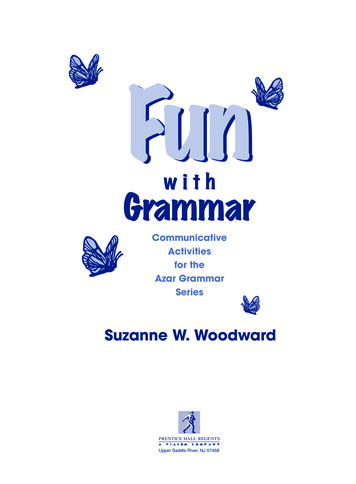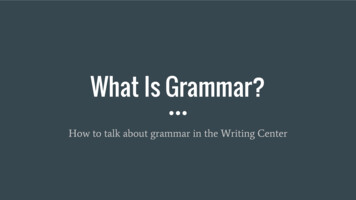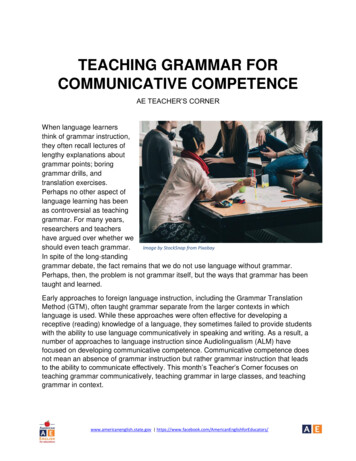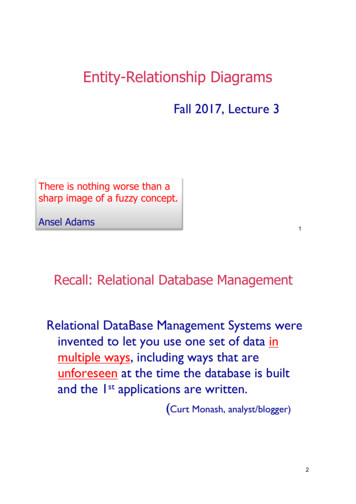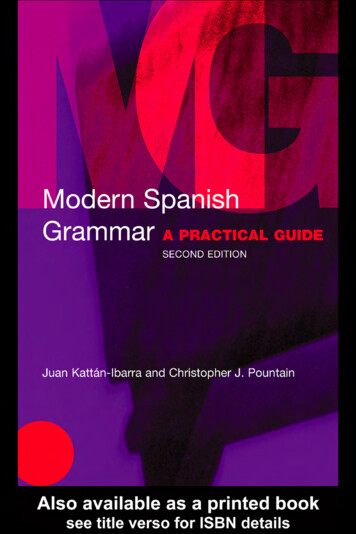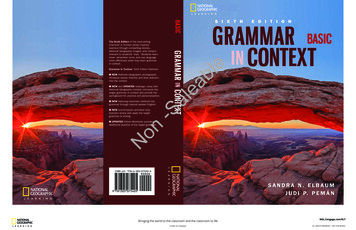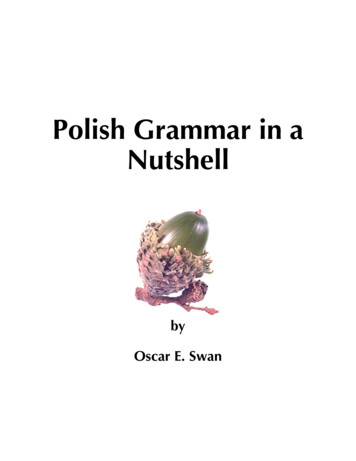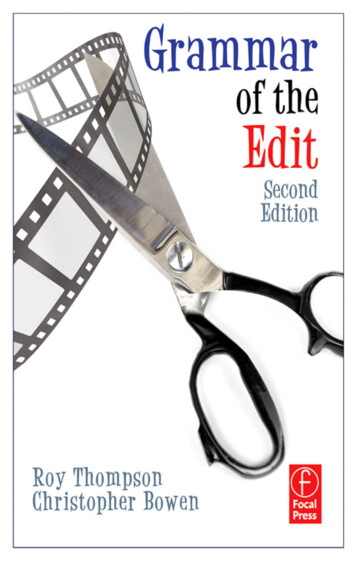
Transcription
Grammar ofthe Edit
This page intentionally left blank
Grammar ofthe EditSECOND EDITIONRoy ThompsonChristopher J. BowenAMSTERDAM BOSTON HEIDELBERG LONDONNEW YORK OXFORD PARIS SAN DIEGOSAN FRANCISCO SINGAPORE SYDNEY TOKYOFocal Press is an imprint of Elsevier
Focal Press is an imprint of Elsevier30 Corporate Drive, Suite 400, Burlington, MA 01803, USALinacre House, Jordan Hill, Oxford OX2 8DP, UKCopyright 2009, Elsevier Inc. All rights reserved.No part of this publication may be reproduced, stored in a retrieval system, ortransmitted in any form or by any means, electronic, mechanical, photocopying,recording, or otherwise, without the prior written permission of the publisher.Permissions may be sought directly from Elsevier’s Science & Technology RightsDepartment in Oxford, UK: phone: (!44) 1865 843830, fax: (!44) 1865 853333,E-mail: permissions@elsevier.com. You may also complete your request on-linevia the Elsevier homepage (http://elsevier.com), by selecting “Support & Contact”then “Copyright and Permission” and then “Obtaining Permissions.”Library of Congress Cataloging-in-Publication DataApplication submittedBritish Library Cataloguing-in-Publication DataA catalogue record for this book is available from the British Library.ISBN: 978-0-240-52120-6For information on all Focal Press publicationsvisit our website at www.elsevierdirect.com09 10 11 125 4 3 2 1Printed in the United States of America
ContentsAcknowledgmentsixIntroductionxiChapter One – Editing BasicsA Little Editing HistoryWhat Factors May Impact Your Editing Choices?The Basic Edit TransitionsStages of the Editing ProcessEnd of Chapter One Review1246711Chapter Two – Understanding the FootageBasic Shot TypesShot DescriptionsExtreme Close-Up (XCU or ECU)Big Close-Up (BCU)Close-Up (CU)Medium Close-Up (MCU)Medium Shot (MS)Medium Long Shot (MLS)Long Shot/Wide Shot (LS/WS)Very Long Shot (VLS)Extreme Long Shot (XLS/ELS)Two-Shot (2-Shot/2S)Over-the-Shoulder Shot (OTS/OSS)Increasing Shot ComplexitySimple ShotsComplex ShotsDeveloping ShotsReviewing the Footage — Selecting the Best Shots13141616171718181920202122232426283031What Could Make or Break a Shot?FocusAudio QualityExposure and Color TemperatureFraming and Composition3234363840
vi ContentsScreen Direction180 Degree Rule/Axis of Action30 Degree RuleMatching AnglesMatching Eye-Line4244464848Continuity of ActionContinuity of DialoguePerformanceBe Familiar with All of the FootageSo How Does All of This Help You?End of Chapter Two Review505152525354Chapter Three – When to Cut and Why?What Factors Help Make a Transition a Good Edit?InformationMotivationShot CompositionCamera AngleContinuityContinuity of ContentContinuity of MovementContinuity of PositionContinuity of SoundSoundIs There a Right or Wrong Reason for a Cut?End of Chapter Three Review5557586062646666686970707374Chapter Four – Transitions and Edit CategoriesThe CutThe DissolveThe WipeThe FadeThe Five Major Categories of Edit TypesThe Action EditThe Screen Position EditThe Form EditThe Concept EditThe Combined Edit7576808486888890919394
Contents viiChapter Five – General Practices for EditorsSound and Vision are Partners and not RivalsA New Shot Should Contain New InformationThere Should Be a Reason for Every EditObserve the Action LineSelect the Appropriate Form of EditThe Better the Edit, the Less It Is NoticedEditing Is CreatingEnd of Chapter Five Review9696979899100102104106108109Chapter Six – Working PracticesEnd of Chapter Six Review111158Chapter Seven – The Final Cut: Additional Editing Topics You AreBound to EncounterAdditional Editing TermsParallel EditingMontageMulti-camera EditingSync Sound and Counting TimeMaking Your Way into the World of EditingTools vs. SkillsDigital WorkflowThe Role of an Assistant EditorIn ConclusionEnd of Chapter Seven 171Index199ContentsWill I Be Quizzed on Any of This?End of Chapter Four Review
This page intentionally left blank
AcknowledgmentsI wish to thank my editors at Focal Press, Elinor Actipis and Michele Cronin, for presenting me with the wonderful opportunity to write the second edition of this time honoredtext, Grammar of the Edit. Of course, this would not be possible without the groundwork done by Mr. Roy Thompson on the first edition. I hope that this revised versioncontinues to inform and inspire all those readers who are just beginning their creativejourney into the world of editing motion pictures.As an educator today, I wish to acknowledge the positive impact that my instructors atBrandeis University and Boston University had on me during my own higher education.The broad scope of the Liberal Arts was great preparation for the specific focus andtechnical craftsmanship that come with the field of film production. I present these samevalues to my own students and I thank them collectively for all they brought to me.As a media professional today, I wish to thank my many colleagues and clients whohave helped me to continue learning with each new project undertaken.I am also grateful for the advice offered by several generous peers in the preparationof this second edition—Joey Goodsell, Norman Hollyn, Jane Jackson, and CatherineSellars.Additionally, I would like to thank my on-camera talent for their time on this project—Wendy Chao, Hannah Kurth, Alexander Scott, Stacy Shreffler, Eliza Smith, and RachaelSwain. All photographs are by the author, as are the line art diagrams and many of theillustrations. I must offer my thanks and appreciation to my co-illustrator, Jean Sharpe,whose distinct style and generous contributions make this text a better learning tool.Also, I offer a note of kind thanks to Mary James for her advice and assistance.Lastly, I acknowledge my family for their support and offer extra special thanks toRachael Swain who has been there through the thick and thin of it all and really helpedpull all the pieces together.This book is for all people who wish to learn the basics about editing film and video.I hope you have fun and enjoy the ride. If you would like to learn more about the topic,find additional resources, or learn more about the author, please visit the author’swebsite www.fellswaycreatives.com.For my mother
This page intentionally left blank
IntroductionEvery motion picture you see and television drama you watch has been edited. Everycommercial, news report, and talk show has been edited. Almost every presentationof motion imagery, whether it is fiction, non-fiction, or a melding of the two, has beenedited — cut down, re-ordered, padded out, massaged, sweetened, and tweaked — toderive the final presentation version. That final version may be exactly what the creators set out to make or it may be entirely different in feel, tempo, information, andemotional impact, but no matter what, the editor helps make it so. It is, then, the job ofthe editor to take the materials created during production and manipulate them to formthe best possible final version that will meet the goals and intentions of the producers.A writer pens the story, a director coaches the actors, a cinematographer creates thevisual style of each shot, and an editor puts all those pieces together. So an editor isreally one of the last creative people to touch a motion picture project. It is his or herskill, craft, and gut instinct that help form the over-arching visual style of the presentation, and often it is also his or her choices that can make or break a program. Of course,an editor can only work as much magic as he or she is given, meaning that the initialquality and quantity of production footage has an awful lot to do with the overall appealof the final, edited result. So certainly it is not all of the editor’s responsibility when aproject is well-received nor is it the editor’s entire fault when things do not go well. Buta good editor can make the difference in the overall final visual presentation.This text, Grammar of the Edit, is designed to indoctrinate the beginner — the novice orthe newbie — into the world of motion picture editing. The rules, guidelines, and general practices presented herein will hopefully provide a new student of this craft with asolid understanding of the basics and perhaps whet the appetite for further explorationof both the discipline’s history and its trends toward tomorrow.Regardless of which direction the fledgling editor will grow, everyone needs to learnhow to walk before they can run and this text should help define the basic terms andclarify the common practices of editing. It does not mention specific computer-basedvideo editing software or particular film-editing tools. It does not wish to delineatebetween images captured on motion picture emulsion film or on electronic analog ordigital video mediums. The term “motion picture” may be used liberally to encompass amyriad of programming types whether shot for theaters, television, or the Web. A particular genre of film or a specific type of television programming may be called out in an
xii Introductionexample to help illustrate a unique point. The goal of this text is to inform a person newto editing about the most generic basics of accepted editing practices, the reasoningbehind them, and their common interpreted meanings. Good technique and not so goodtechnique may be discussed and illustrated, but in the end there is no right and there isno wrong, there is only what works and what does not work — and why.
Chapter OneEditing BasicsQUESTION: What is editing?ANSWER: Editing for motion pictures is the process of organizing, reviewing, selecting, and assembling the picture and sound “footage” captured during production. Theresult of these editing efforts should be a coherent and meaningful story or visual presentation that comes as close as possible to achieving the goals behind the originalintent of the work — to entertain, to inform, to inspire, etc.When you write, you select words from your vocabulary and string them together in aparticular fashion to construct sentences that will inform, entertain, or evoke emotionalresponses within the reader. When you edit a motion picture, there is a similar process.You have to select shots and string them together in edited scenes to inform, entertain,or evoke emotional responses within the viewer. For your written sentences to makesense to readers you must follow the known and accepted rules of grammar for yourwritten language — spelling, word order, phrase structure, tense, etc. There is also asimilar visual grammar for the language of motion pictures — how they are shot andhow they are edited together.In the companion text, Grammar of the Shot, these basic rules of structure and form inshooting the individual pictures are discussed in detail. This text, Grammar of the Edit,presents the basic rules of visual construction that will allow you to take these sameshots and assemble them together into a meaningful story. As a creative entity, youmay choose to edit your visual elements however you wish, but it must be understoodthat there are certain basic rules and guidelines that are commonly accepted in theentertainment and visual communication fields. The chapters of this book are designedto help you understand the grammar behind the editing process and set you on a pathto good editing practices.
2 Grammar of the EditA Little Editing HistoryLong before the existence of digital videotape and computer editing software, peopleused emulsion film to create the illusion of motion pictures. Over one hundred yearsago, the nascent technology of emulsion film strips and hand-cranked moving film cameras only allowed for roughly one minute of any event to be photographed. Many of theoriginal movies were just roughly one-minute long recordings of events in real time. Veryquickly the technologies advanced and the use of motion pictures moved from straightdocumentary presentations that amazed to more elaborate fictional narrative stories thatentertained. Longer strips of film allowed for longer recording times. As film’s visual language began to develop, more shot variety was introduced and motion pictures becamegrander in scope. Editing the larger amount of photographic material grew out of theneed to trim the visual “fat” and to better structure the story shown to an audience.Within just a short few decades, a more complex visual language of motion picturephotography and editing had evolved. Films were quickly becoming the largest entertainment and information medium on the planet. They were held in high esteem bymany and defamed by others. Motion pictures and how they were perceived by audiences became a source of study. Many theories about the impact of filmmaking, andthe editing process especially, emerged from different cultures around the world.When the editor cut the film and how the various shots were joined together wereseen to have an impact on the viewing audience above and beyond the actual story.Editing was no longer just a means to physically trim the excess footage from a seriesof shots, but it had become recognized as a powerful tool in the filmmaker’s toolbox.The machines used to take the pictures and to perform the cuts have evolved over time,but most of the basic rules of visual grammar have remained the same. Differing editorial styles have come and gone, but the core methods and intent behind the practice areunchanged even today.
This page intentionally left blank
4 Grammar of the EditWhat Factors May Impact Your Editing Choices?So, if editing is the assembly of individual shots of picture and sound into a coherentstory, then an edit must be the place where you transition from one of those shots intothe next within that assembly. Put simply, an edit is a cut point — a place where oneshot ends and another separate shot begins. (see Figure 1.2) The term “cut” stems fromthe days when motion pictures were shot and edited on very long strips of emulsionfilm. Looking at the individual still frames on that strip of film, the editor would determine where to physically cut the film between pictures. A pair of scissors or a razorblade device was used to actually cut the film at that point (see Figure 1.1). Glue ortape was then used to join the different cut strips of plastic film together again. The cutor join then becomes the point of transition from one shot to the next. The straight cutdescribed here is just one way to move between shots. How you choose to transitionfrom one shot to another depends on many variables.The first factor you may wish to consider is what medium you are using to perform thephysical edits — film, tape-to-tape video, or computer-aided digital video. Each medium,and the devices that are used in the editing process, can often dictate physical, timerelated, or financial limitations. Many argue that computer-aided digital video editing isthe most economical and the most diverse as far as options for editing go, and it is,most likely, the type of editing that you, the reader, will be performing. In this text weare attempting to keep the discussions of editing grammar as generic as possible, sothe general rules and practices presented should apply to any medium and to any editing device or software. Just be aware that certain terminology used in one medium mayhave its origins rooted in another and may vary from one software application to another.A second factor that may impact your editing transition choices can be the kind of project that you are editing. Are you assembling footage for a documentary, a fictional narrative short film, a news package, a music video, a television commercial, or a cousin’sFIGURE 1.1 Initially, editing motion picture filmrequired very basic technologies.FIGURE 1.2 The film strip of shot B is “edited” ontothe end of shot A.
Chapter One Editing Basics5Other factors involved with editorial and transition choices include your own creativity,the vision of the director, the suggestions of a producer, and the quality of the raw footage that you are tasked with editing together. Remember, the right editor can breathenew life into old, tired, or boring material, but an editor may still have to answer toother limiting factors as discussed above. The point is, an editor performs the task ofediting but she or he does not always have control over the many variables that impactthe process.What Factors May Impact Your Editing Choices?wedding video? Each type of project or program may necessitate a certain editing styleand usage of particular transitions. For instance, you may wish to use long, slow dissolves from one shot to the next in a moody music video, but you would never considerusing long, slow dissolves in a hard-hitting, factual news package for the six o’clocknews. We will discuss dissolves in more detail later, but the example illustrates theimportance of following the accepted rules and guidelines of style for differing programtypes and for genres within those distinct types. For the purposes of clarity and simplicity, we will mostly focus on the grammar and practices associated with fictional narrative motion picture storytelling, but the general guidelines apply to all forms of motionimage programming.
6 Grammar of the EditThe Basic Edit TransitionsLet us begin our discussion of editing with the edit point itself.There are four basic ways one can transition from one shot or visual element intoanother: Cut — An instantaneous change from one shot to the next. The last full frame ofpicture for one shot is immediately followed by the first full frame of picture forthe next shot.Dissolve — A gradual change from the ending pictures of one shot intothe beginning pictures of the next shot. This is traditionally achieved via asuperimposition of both shots with a simultaneous downward and upward rampingof opacity over a particular period of time. As the end of the first shot “dissolves”away, the beginning of the next shot “resolves” onto the screen at the same time.Wipe — A line, progressing at some angle, or a shape, moves across the screenremoving the image of the shot just ending while simultaneously revealing thenext shot behind the line or the shape. The wiping shot replaces the previousshot on the screen.Fade — (1) A gradual change from a solid black screen into a fully visible image(fade from black or fade-in). (2) A gradual change from a fully visible image into asolid black screen (fade to black or fade-out).The grammar of the edit has evolved in some ways since the early days of cinema, butthese four basic transitions have remained the same. No matter what type of programyou are editing or what tool you are using to make it, a cut is still a cut. A dissolve isstill a dissolve no matter what pictures you dissolve from and to. A wipe will literallywipe a new shot over the old shot. A fade-in still comes out of black and a fade-out stillgoes into black. They have remained the same because their individual purposes haveremained the same, and, for the most part, everyone around the world understandstheir grammar — or what it means when they see one being used as a transition.Later in this text you will be able to explore a more in-depth analysis of these basicediting transitions. For now, let us place them aside and focus our attentions on a muchbroader topic — a general approach to the entire editing process.Your goal is to have a finished piece that plays for your audience and provides as muchentertainment or information as it can. To achieve that finished piece, though, there areseveral stages of the editing process that you will, most likely, need to follow.
Chapter One Editing Basics7Stages of the Editing ProcessThe editing process, more generally referred to as post-production or sometimes justpost, can range from being rather simple to extremely complex. The post-productionperiod really encompasses any and all work on the project that comes after the shooting (the production) is completed. Picture and sound tracks are edited together toshow and tell the story, special visual effects are generated, titles/graphics/creditsare added, sound effects are created, and music is scored during post-production. Onsmaller projects, one person can do all of this work, but on larger productions, severalteams of women and men work in various departments to complete each element andjoin each phase of the post-production workflow. Acquire Organize Review and select Assemble Cut — rough Cut — fine Picture lock Master and deliverAcquisition — Simply put, you must acquire the footage shot by the productionteam. Motion picture and sound elements, whether on emulsion film, analogtape, digital tape, or digital files, must be gathered together for the durationof the post-production editing process. The medium of choice depends on themethod of editing and the physical devices used to perform the edits. If you areusing a computer-aided digital non-linear editing system to perform the edit,then you will have to import, capture, or “digitize” all materials as media onyour storage drives. These media files must remain accessible by your editingsoftware for the life of the project for you to complete the work.Organization — All of the minutes, hours, feet, reels, or gigabytes of picture andsound elements should be organized in some way. If you do not have a clearsystem of labeling, grouping, or sorting all of the material needed for your project,you will eventually have a difficult time finding that good shot or that good soundStages of the Editing ProcessThe following is a low-level listing of the major steps involved in a post-productionworkflow that stresses the editing process for the visual elements of a project.
8 Grammar of the Editeffect, etc. Organization of source materials is not the most glamorous part of theedit process, but it can certainly make the difference between a smoothpost-production workflow and a slower and more frustrating one. Many of thebetter editors and assistant editors are highly prized for their organizationalskills. Tame the chaos into order and craft the order into a motion picture.Review and selection — Once you have acquired and organized all of yourelements, it will be necessary to review all of this material and pick out the bestpieces that will work for your project. You will “pull the selects” and set asidethe good stuff while weeding out the junk that you hope you will not have to use.You would be wise to not actually throw anything away, however, because youwill never know what might come in handy a day or a few weeks into the editingprocess. That one scrap of footage of the flag waving in the breeze may just savethe entire edit, so keep it readily available even though you know it is not one ofyour original selections.Assembly — This process calls for assembling all of the major pieces of the projectinto a logical sequence of picture and sound elements. If you are editing ascripted story, you would follow that script as a blueprint for assembling the bestselections of the various shots of the scenes that make up the motion picture.If you are creating a documentary or even a music video, there is always somestory that is trying to be shown to an audience — assemble those raw parts intothis skeleton version. No matter what genre the project, the story, in its longestand most rough-hewn form, takes shape now.Rough cut — This is a stage of the project’s development where the majority of the“fat” has been trimmed and you are left with a presentation that is complete inits narrative flow but has many rough edges. Perhaps not every cut is perfectlytimed yet, there are no finalized titles or graphics, simple or more elaborateeffects have not been created, and the audio mix certainly has not beencompleted. You do have the timing of the main elements down to a good pace,however, and you, and others to whom you show the developing work, like howthe story unfolds, although restructuring of scenes may still occur.Fine cut — You have worked and re-worked and massaged the material of yourproject into a tight and finely tuned presentation. There will be no majorrenovations from this point forward. You, and the majority of the people to whomyou show the piece, all agree that no further tweaks are required. This cut is fine.Picture lock — You have reached picture lock when you are absolutely certain thatyou will not make any more changes to the picture track(s) of your edited piece.
Chapter One Editing Basics9The timing of all picture elements (shots, titles, black pauses, etc.) is set. Onceyou have locked the picture tracks (sometimes literally but mostly figuratively),you are then free to address your audio mixing needs. Once the audio tweaks arefinalized and your music is in place, then you are ready for the last stage.Stages of the Editing ProcessMastering and delivery — All of your efforts in creating a well-edited piece willmean very little if you cannot deliver the show to the audience that needs tosee it. These days this process may mean recording your final cut onto videotape, creating an optical film print for projection in a movie theatre, convertingFIGURE 1.3 The general stages of the editing process.
10 Grammar of the Edityour story into a computer video file, or authoring the piece onto a DVD. Eachmedium would require a unique process, but the end result is that you have afully mastered version of your show and an audience gets to view all of your hardediting work.So we now have a pretty good idea of what the basic editing, or post-production workflow is for any project large or small. You certainly may encounter projects that do notcall for all the stages of editing to be executed in a clearly delineated manner, but, forthe most part, you will touch upon some combination of each of these stages as youwork toward your finished piece.
Chapter One Editing Basics11End of Chapter One Review1. There are basic and widely accepted rules of visual grammar that govern themotion picture editing process.2. The grammar of the edit has evolved over a century of filmmaking, but the basics,covered in this book, have remained largely unchanged.3. There are many factors that play a role in how a motion picture is edited and theeditor does not always have control over many of them.4. The four basic types of transition edits are cut, dissolve, wipe, and fade.End of Chapter One Review5. The basic post-production workflow consists of the following stages: acquisition,organization, review and selection, assembly, rough cut, fine cut, picture lock,and master and delivery.
This page intentionally left blank
Chapter TwoUnderstanding the FootageQUESTION: Why should an editor be well versed in the variousshot types?ANSWER: Consider the individual shot types as the vocabulary — the visualphrases — used to edit together complete scenes in a motion picture. Knowing the“words” and their meaning will help an editor construct more meaningful visual sentences.When you watch a stage play, a music concert, or a sports event in an actual publictheatre, club, or stadium you generally only get to observe the actions of the performers from one static viewpoint — your seat. If any of these events were recorded andbroadcast on television, the person watching at home, although missing out on the thrillof being at the live event, will benefit from having a more “intimate” viewing experience thanks to the event’s coverage by multiple cameras of varying positions and lensfocal lengths. The person at home “sees” more views and details than the person atthe actual event.It is this same concept of coverage that allows people watching a motion picture tofeel as though they are observing actual events unfolding before their eyes. They getto “see” more because the camera records the people, places, and actions from manydifferent vantage points and with varying degrees of detail. The production team photographs all of the important action from what they consider to be the most advantageousand necessary points of view. Each one of these camera views is called a shot.These shots, or individual units of visual information, are eventually given to the editorduring post-production. Even though the editor had no control over which shots wererecorded on the film set or how they were composed, it will be his or her job to reviewall of the material and choose the best viewpoints — pull the selects — and combinethese various shots to show the audience the best visual presentation of the action inthe story, whatever it may be.
14 Grammar of the EditBasic Shot TypesMost editors only get involved with a project during post-production. Although manyprofessional editors may have worked in production on a film set or in a studio at somepoint in their careers, it is not that common for them to work both production and postproduction jobs. What is common, however, is the need for all editors to know certainproduction concepts and terminologies and be well-versed in the visual grammar offilmmaking. Knowing the basic shot types and how to best juxtapose them during theedit is a key responsibility for the editor. He or she must know how to best “show” thestory. So as a review, we will present the following section which highlights and illustrates the main building blocks of film language — the basic shots. Extreme close-up (XCU or ECU) Big close-up (BCU) Close-up (CU) Medium close-up (MCU) Medium shot (MS) Medium long shot (MLS) Long shot (LS) or wide shot (WS) Very long shot (VLS) Extreme long shot (XLS or ELS) Two shot (2S) Over the shoulder (OTS)
FIGURE 2.1 The extended family of film’s basic shot types.
16 Grammar of the EditShot DescriptionsThe basic shot types can be used to record any subject or objects of varying sizes, butto keep the examples grounded in an easily understood relationship, we are going tomainly focus our attention on the framing of a human subject. It shoul
clarify the common practices of editing. It does not mention specifi c computer-based video editing software or particular fi lm-editing tools. It does not wish to delineate between images captured on motion picture emulsion fi lm or on ele





